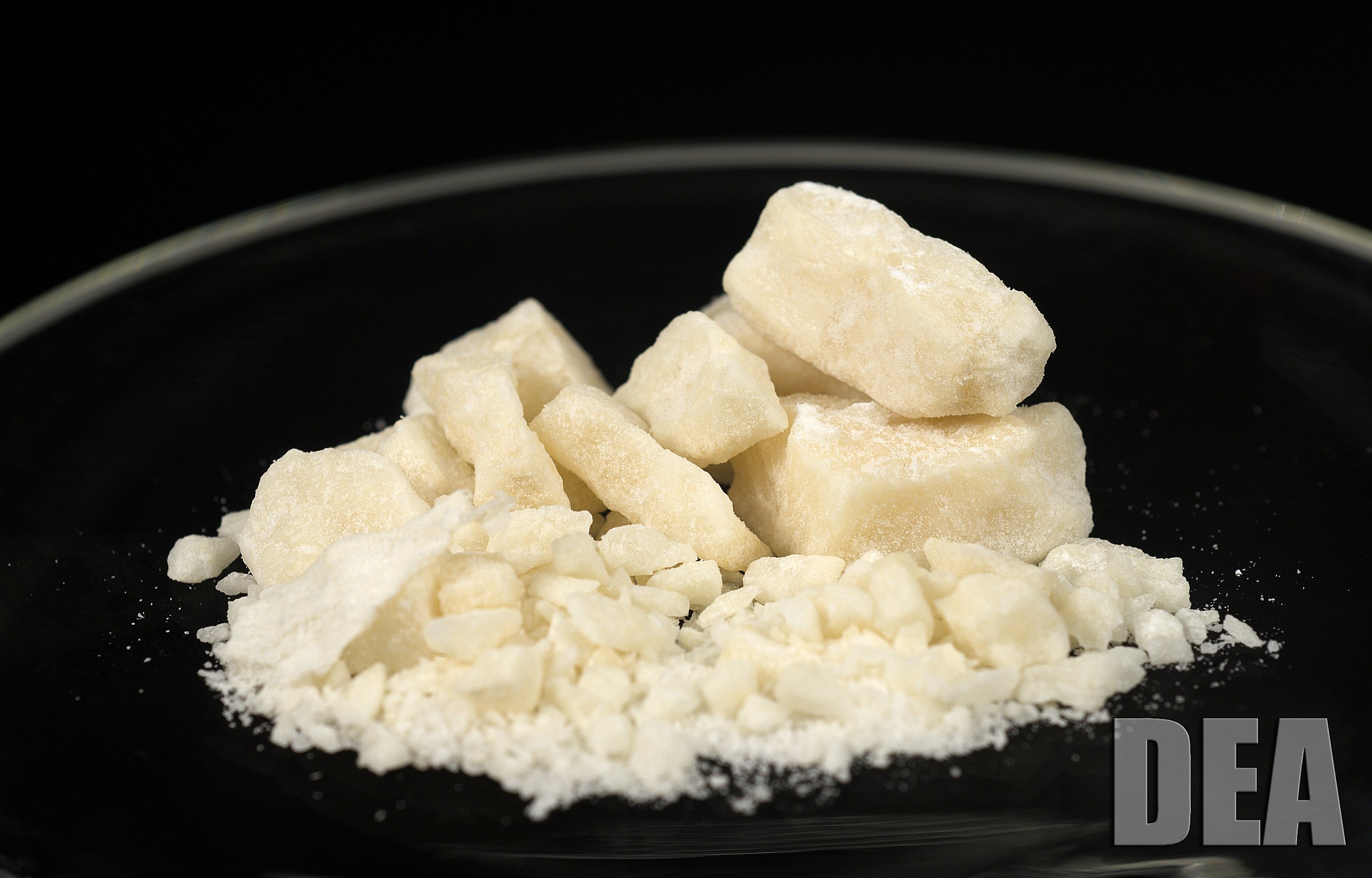What is cocaine?
Cocaine is a powerfully addictive stimulant that produces an intense euphoric effect. It is classified as a Schedule II substance, which means it has a high risk for addiction.
Cocaine is derived from coca leaves grown in Bolivia, Peru, and Colombia. Colombia produces about 90 percent of the cocaine powder reaching the United States with most of the cocaine entering the U.S. coming through Mexico.
Cocaine is usually distributed as a white, crystalline powder (snow). Cocaine dealers often dilute (“cut”) it with a variety of substances, such as cornstarch, talcum powder, flour, or baking soda. This allows dealers to produce more at a lower cost, increasing their profits. Cocaine may also be cut with other drugs, such as amphetamines (2) or opiates, including fentanyl.
Crack cocaine looks like small, irregularly shaped “rocks” that are whitish in color. Crack is produced by dissolving powder cocaine in water and ammonia or baking soda and boiling it until a solid is formed. This solid is then cracked and broken into “rocks.” Crack produces an immediate high and is inexpensive to produce, making it more affordable and leading to a high rate of abuse. (3)
Street names: Blow, Coca, Coke, Crack, Flake, Snow, and Soda Cot.
Cocaine is usually snorted, dissolved in water and injected intravenously or intramuscularly, or smoked. Crack cocaine also can be added to marijuana or tobacco and smoked. Some individuals take it in combination with opioids, like heroin, which is called “speedballing” and is especially dangerous. (2)
Short-term Effects
The method an individual chooses to use cocaine impacts the speed at which the drug reaches the brain, affecting the drug’s intensity. After smoking or injecting, cocaine reaches the brain in seconds, which leads to an intense euphoric effect known as a “rush.” When a person snorts cocaine, the build-up in the brain is slower, which results in a less intense effect.
Short-term effects of cocaine use:
Increased alertness
Dilated pupils
Increased body temperature
Increased heart rate and blood pressure
Hypersensitivity to light, sounds, and touch
Excitability
Headache
Restlessness
Irritability
Anxiety
Normal pupil size
Dilated pupil
In some cases, users may experience life-threatening medical conditions such as heart attack, stroke, and coma. Prolonged use or high doses may lead to aggressive, erratic, and paranoid behavior. Often individuals who use cocaine also use alcohol, which is a dangerous combination because they react in a way that increases the toxic effects on the heart. (4)
After the euphoric “rush” wears off, individuals may experience a “crash,” where they feel mental and physical exhaustion and even depression.2 The length of the high also depends on how the cocaine was administered. The high from smoking or injecting is more immediate, but may only last 5-10 minutes, whereas a high from snorting has a slow onset, but can last 15-30 minutes. Because tolerance to cocaine’s effects develops rapidly, users need to take increasingly higher doses to achieve the same results.
Individuals ingesting cocaine, in any form, may have a cocktail of multiple substances in their system, such as amphetamines, alcohol, or heroin.
Long-term Effects
Long-term effects of cocaine use:
Loss of sense of smell
Nosebleeds
Problems with swallowing
Hoarseness
Chronically inflamed, runny nose
Lung trauma (crack cocaine)
Higher risk for contracting infectious diseases such as HIV and Hepatitis C (from injecting)
Ulcers
Weight loss and malnourishment
Chest pain
Stroke
Impaired cognitive and gross-motor skills
Crack cocaine. Source: DEA
Since tolerance to cocaine’s effects develops rapidly, the brain starts to adapt and the reward pathways become less sensitive, so users need to take increasingly higher doses to achieve the same results. More frequent use along with higher doses are needed to achieve the same level of pleasure, which can prompt individuals to “binge” and take high amounts in short periods of time. Users can also develop sensitization – less cocaine is needed to produce anxiety, convulsions, or other toxic effects. This combination of tolerance and sensitization can lead to increased levels of cocaine use. Not only does this escalation in use potentially lead to more irritability, restlessness, panic attacks, paranoia, and even full-blown psychosis, but it also increases the risk of overdose. (5)
Individuals ingesting cocaine, in any form, may have a cocktail of multiple substances in their system, such as amphetamines, alcohol, or heroin.
Possible Signs of Cocaine Overdose
Hyperthermia
Elevated blood pressure and heart rate
Changes in respiration
Chest pain
Nausea and vomiting
Tremors
Anxiety and panic attacks
Paranoia and hallucinations
Excited delirium
Seizures
In case of an overdose
Call 911.
Prevent injury – If the person is having a seizure, gently hold the back of their head, but do not restrain their arms and legs.
Stay with the individual until emergency responders arrive.
According to the National Institute on Drug Abuse (NIDA), cocaine overdose is brought on by a person taking enough of the drug to reach toxicity, causing a serious reaction within the body. The amount of cocaine required to cause an overdose depends on the individual user and their specific susceptibility to the toxins.
The individual may have a cocktail of multiple substances in their system, such as amphetamines, alcohol, or heroin.
According to the NIH, one form of behavioral therapy that is showing positive results in people with cocaine use disorders is contingency management (CM), also called motivational incentives.
Treatment
According to the NIH, one form of behavioral therapy that is showing positive results in people with cocaine use disorders is contingency management (CM), also called motivational incentives. Programs use a voucher or prize-based system that rewards patients who abstain from cocaine and other drugs. On the basis of drug-free urine tests, the patients earn points, or chips, which can be exchanged for items that encourage healthy living, such as a gym membership, movie tickets, or dinner at a local restaurant.
Cognitive behavior therapy (CBT) is an effective approach for preventing relapse. This approach helps patients develop critical skills that support long-term abstinence. This includes learning to recognize the situations in which they are most likely to use cocaine, avoid these situations, and cope more effectively with a range of problems associated with drug use. (6)
(1) National Institute on Drug Abuse & National Institutes of Health. (2016, May). Cocaine Research Report. What is Cocaine? https://nida.nih.gov/publications/research-reports/cocaine/what-cocaine
(2) Drug Enforcement Administration. (2019, December). Cocaine. https://www.deadiversion.usdoj.gov/drug_chem_info/cocaine.pdf
(3) National Drug Intelligence Center & U.S. Department of Justice. Crack Cocaine Fast Facts. https://www.justice.gov/archive/ndic/pubs3/3978/3978p.pdf
(4) National Institute on Drug Abuse & National Institutes of Health. (2016, May). Cocaine Research Report. What Are the Short-Term Effects of Cocaine Use? https://nida.nih.gov/publications/research-reports/cocaine/what-are-short-term-effects-cocaine-use
(5) National Institute on Drug Abuse & National Institutes of Health. (2016, May). Cocaine Research Report. What Are the Long-Term Effects of Cocaine Use? https://nida.nih.gov/publications/research-reports/cocaine/what-are-long-term-effects-cocaine-use
(6) National Institute on Drug Abuse & National Institutes of Health. (2016, May). Cocaine Research Report. How is Cocaine Addiction Treated? https://nida.nih.gov/publications/research-reports/cocaine/what-treatments-are-effective-cocaine-abusers





